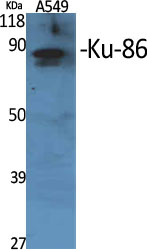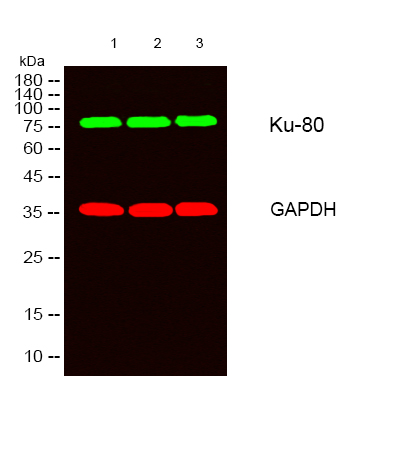INCENP (Phospho Thr59) rabbit pAb
- Catalog No.:YP1759
- Applications:WB
- Reactivity:Human;Mouse;Rat
- Target:
- INCENP
- Gene Name:
- INCENP
- Protein Name:
- INCENP (Phospho-Thr59)
- Human Gene Id:
- 3619
- Human Swiss Prot No:
- Q9NQS7
- Mouse Gene Id:
- 16319
- Mouse Swiss Prot No:
- Q9WU62
- Immunogen:
- Synthesized peptide derived from human INCENP (Phospho-Thr59)
- Specificity:
- This antibody detects endogenous levels of INCENP (Phospho-Thr59) at Human, Mouse,Rat
- Formulation:
- Liquid in PBS containing 50% glycerol, 0.5% BSA and 0.02% sodium azide.
- Source:
- Polyclonal, Rabbit,IgG
- Dilution:
- WB 1:500-2000
- Purification:
- The antibody was affinity-purified from rabbit serum by affinity-chromatography using specific immunogen.
- Concentration:
- 1 mg/ml
- Storage Stability:
- -15°C to -25°C/1 year(Do not lower than -25°C)
- Other Name:
- Inner centromere protein
- Molecular Weight(Da):
- 101kD
- Background:
- In mammalian cells, 2 broad groups of centromere-interacting proteins have been described: constitutively binding centromere proteins and 'passenger,' or transiently interacting, proteins (reviewed by Choo, 1997). The constitutive proteins include CENPA (centromere protein A; MIM 117139), CENPB (MIM 117140), CENPC1 (MIM 117141), and CENPD (MIM 117142). The term 'passenger proteins' encompasses a broad collection of proteins that localize to the centromere during specific stages of the cell cycle (Earnshaw and Mackay, 1994 [PubMed 8088460]). These include CENPE (MIM 117143); MCAK (MIM 604538); KID (MIM 603213); cytoplasmic dynein (e.g., MIM 600112); CliPs (e.g., MIM 179838); and CENPF/mitosin (MIM 600236). The inner centromere proteins (INCENPs) (Earnshaw and Cooke, 1991 [PubMed 1860899]), the initial members of the passenger protein group, display a broad localization alo
- Function:
- caution:PubMed:11139336 experiments have been carried out partly in chicken and partly in human.,function:Component of the chromosomal passenger complex (CPC), a complex that acts as a key regulator of mitosis. The CPC complex has essential functions at the centromere in ensuring correct chromosome alignment and segregation and is required for chromatin-induced microtubule stabilization and spindle assembly. Probably acts through association with AURKB or AURKC. Seems to bind directly to microtubules.,similarity:Belongs to the INCENP family.,subcellular location:Localizes on chromosome arms and inner centromeres from prophase through metaphase and then transferring to the spindle midzone and midbody from anaphase through cytokinesis. Colocalizes with AURKB at mitotic chromosomes.,subunit:Homodimer or heterodimer. Interacts with H2AFZ (By similarity). Interacts with CBX3. Interacts with t
- Subcellular Location:
- Nucleus . Chromosome, centromere . Cytoplasm, cytoskeleton, spindle . Midbody . Chromosome, centromere, kinetochore . Colocalized at synaptonemal complex central element from zygotene up to late pachytene when it begins to relocalize to heterochromatic chromocenters. Colocalizes with AURKB at a connecting strand traversing the centromere region and joining sister kinetochores, in metaphase II centromeres. This strand disappears at the metaphase II/anaphase II transition and relocalizes to the spindle midzone (By similarity). Colocalizes with AURKB at mitotic chromosomes (PubMed:11453556). Localizes to inner kinetochore (PubMed:16760428). Localizes on chromosome arms and inner centromeres from prophase through metaphase and then transferring to the spindle midzone and midbody from anaphase
- Expression:
- Epithelium,Lung,Testis,
- June 19-2018
- WESTERN IMMUNOBLOTTING PROTOCOL
- June 19-2018
- IMMUNOHISTOCHEMISTRY-PARAFFIN PROTOCOL
- June 19-2018
- IMMUNOFLUORESCENCE PROTOCOL
- September 08-2020
- FLOW-CYTOMEYRT-PROTOCOL
- May 20-2022
- Cell-Based ELISA│解您多样本WB检测之困扰
- July 13-2018
- CELL-BASED-ELISA-PROTOCOL-FOR-ACETYL-PROTEIN
- July 13-2018
- CELL-BASED-ELISA-PROTOCOL-FOR-PHOSPHO-PROTEIN
- July 13-2018
- Antibody-FAQs
- Products Images

- Western Blot analysis of various,using primary antibody at 1:1000 dilution. Secondary antibody(catalog#:RS23920) was diluted at 1:10000

